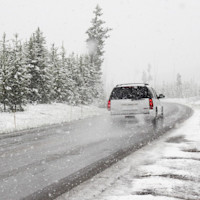Winter Driving Preparedness and Safety Tips

Winter can turn even the simplest drive into a serious challenge. Snow, ice and freezing rain create slick roads, limited visibility and unpredictable conditions that make driving more difficult and more dangerous.
Whether you're commuting to work or heading out on a road trip, being prepared for winter weather can make the difference between getting home safely and getting stranded.
Winter Emergency Road Kit Supplies
If your car breaks down or you get stuck in snow, having an emergency kit can keep you safe and comfortable until help arrives. Store these essentials in your trunk before winter begins:
- Warm Clothing and Blankets: Pack gloves, hats, scarves and a heavy blanket to help you stay warm.
- Non-Perishable Food and Water: Granola bars, nuts and bottled water are easy to keep in your car.
- Flashlight and Extra Batteries: You'll need light if you're stuck after dark.
- First Aid Kit: Include bandages, antiseptic wipes and basic medication.
- Ice Scraper and Snow Brush: Clear ice from your windshield and lights before driving.
- Shovel and Sand or Kitty Litter:These can help you dig out and gain traction if you're stuck.
- Jumper Cables: Cold weather can drain batteries quickly.
- Phone Charger and Power Bank: Keep your devices charged for communication or navigation.
Preparing Your Car for Winter
Your car should get some attention before the first snowfall. Cold temperatures affect every part of a vehicle, from tire pressure to fluids. Here's how to get your car ready for winter:
- Check Your Tires: Make sure they have good tread and proper inflation. Consider snow tires if you live in an area that gets a lot of snow or ice.
- Top Off Fluids: Keep your windshield washer fluid full, making sure that it's rated for freezing temperatures and ensure that your antifreeze is at the right level.
- Inspect Your Battery: Batteries lose power in the cold, so test yours and replace it if it's weak.
- Replace Worn Wiper Blades: Visibility is key in snowy weather. Use heavy-duty wipers designed for snow.
- Keep Your Gas Tank at Least Half Full: This prevents your fuel line from freezing and gives you reserve fuel if you're delayed.
Extra Safety Steps to Consider
Sometimes the smallest precautions can have the biggest impact. Before setting out, check the weather forecast and the road conditions.
If travel looks risky, postpone your trip if possible. If you do have to go out, drive slowly so you have more time to brake or turn, especially if you're a first-time driver without a lot of experience driving in wintry conditions. On icy roads, sudden movements can cause you to lose control.
Keep your headlights and taillights on even during the day so other drivers can see you. Clear snow and ice from your entire vehicle before driving, including the roof; flying chunks can endanger other motorists. And always tell someone your route and expected arrival time before setting out, especially if you'll be traveling through remote areas.
How to Avoid an Accident
Defensive driving is always a good idea, but it becomes even more important in winter. Maintain a greater following distance, at least 8 to 10 seconds behind the vehicle ahead, to give yourself room to stop on slick pavement.
If your car begins to skid, stay calm and steer gently toward the direction you want to go. Avoid slamming on the brakes; instead, ease off of the accelerator and let your tires regain traction.
Use your low beams in heavy snow or fog to reduce glare, and avoid using cruise control on slippery roads. Most importantly, don't drive while distracted or fatigued. Winter driving requires your full attention.
Additional Resources
- A Short Guide to Winter Driving
- Winter Driving Safety Tips
- Student Guide to Driving in the Winter
- What to Know About Winter Driving
- Tips for Safe Driving in the Winter
- Winter Driving: Be Prepared and Be Safe
- Virginia Driver Education Course
- Safe Winter Driving Tips
- Tips for Safe Driving in the Winter
- First-Time Driver Courses in Florida
- Dispelling Myths About Winter Driving
- Checklist for Winter Driving
- Florida Online DETS Course
- Quick Guide to Winter Driving Safety
- Know the Hazards of Winter Driving
- Ohio Teen Driver Education Online
- Six Safety Tips for Winter Driving
- Winter Weather Safety Tips

